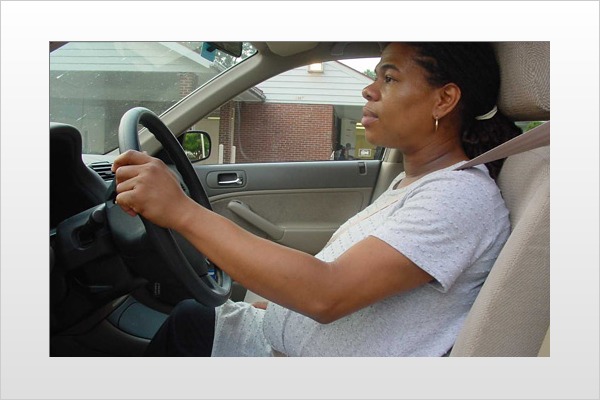
There isn't a lot of data about the safety of pregnant women and their unborn babies in car crashes and, as a result, there is a lot of misinformation. The most common: that seatbelts and airbags pose big risks.
Federal car crash databases don't regularly mention whether drivers or occupants were pregnant, and death certificates of fetuses don't cite whether the mother-to-be was in a car. However, researchers estimate the number of deaths is close to 400 each year from car crashes alone, making it the biggest injury-related danger to the unborn.
But studies do show that while seatbelts and airbags can pose risks to a fetus, it's almost always because the seatbelt wasn't worn at all, was worn incorrectly or the pregnant driver was positioned too close to the airbag.
After all, the leading cause of death to fetuses is the death of pregnant women in crashes.
"The primary way to protect the fetus is to protect the driver," says Lotta Jakobsson, a biomechanics and injury-reduction specialist for Volvo in Sweden.
If a pregnant woman survives a crash, the next biggest danger is "placental abruption." That's when the placenta separates from the uterus and disrupts the flow of oxygen and nutrients to the fetus. This can be caused when too many of the crash forces are transmitted to the woman's pregnant belly, either because it makes contact with a part of the car (like the steering wheel or dashboard), the belt is worn improperly (too high) or the bag hits it with too much force.
To reduce the risk to their most precious cargo, pregnant women need to drive carefully, of course. But because you can't avoid all crashes, it's important to wear the safety belt correctly — with the lap belt under, not across your belly and the shoulder belt between your breasts. Pregnant women who aren't wearing safety belts and sit so their abdomens are right up against the airbag when it deploys are putting their babies at the most risk. Studies show that using seatbelts properly nearly eliminates the increased risk from airbags in car crashes.
The keys to car safety while pregnant:
Some Car Company Help
Car companies have been making it easier for everyone to wear belts properly. Current designs facilitate comfortable positioning of the steering wheel, enabling even pregnant women to adjust the steering wheel in a way that keeps them from sitting too close to the bag.
Many automakers, including Volvo, have moved the lower anchors for seatbelts a bit farther forward so they can be more easily worn close to the pelvic bone, Jakobsson says.
Some automakers attach the upper anchors to the seat back rather than the B-pillar, which is the area between the front and back windows. This is more common in coupes and sports cars (so people can get in the backseat more easily without climbing under the belt), but can also be found, for example, in the 2007 Cadillac SRX SUV.
Since the 1998 model year, cars with upper seatbelts that come out of the B-pillar are also required to have adjustable anchors. This helps everyone, from the tallest to the shortest — to the most pregnant — driver and passenger to keep belts from cutting into their necks or riding across their breasts. Belts should be worn across the "strongest part of the chest," says Jakobsson, which is between — not across — the breasts.
There are some aftermarket products available to help further adjust safety belts, but automakers and federal regulators often warn against using them, so they should only be relied on if it's otherwise impossible to get the belts positioned correctly and comfortably. Phil Haseltine, president of the Automotive Coalition for Traffic Safety, notes that these products aren't covered by any safety standards and might actually decrease the belt's performance in a crash.
Adjustable steering wheels, particularly ones that telescope in and out, can be especially helpful for drivers of varying sizes — and stages of pregnancy. Even lower-end models often have manual devices that can help you point the center of the steering wheel away from the belly and toward the chest.
Adjustable pedals, now available in many Fords and other models, can help shorter pregnant women drive more easily without sitting too close to the airbag. There are also several aftermarket versions available; although they come with some of the same cautions as other aftermarket devices, they should improve safety if installed professionally.
More Testing and Education Needed
Automakers consider the pregnant female — or at least a reasonable facsimile — in their testing. At least one company sells a crash test dummy that simulates a pregnant woman that some automakers use, and Volvo regularly tests using a computer-simulated pregnant dummy. See our article, "The Female Dummy" for specifics.
With more women working in auto safety, pregnant drivers are getting more attention. National Highway Traffic Safety Administration Chief Nicole Nason says the agency is mulling whether its current safety belt regulations prevent automakers from designing belts that could be even safer for pregnant motorists. In a 2006 report, former Insurance Institute for Highway Safety Research Chief Susan Ferguson said more education is needed so pregnant women know the keys to seatbelt safety, and she pushed for more research on the effects airbags have on women and their fetuses.